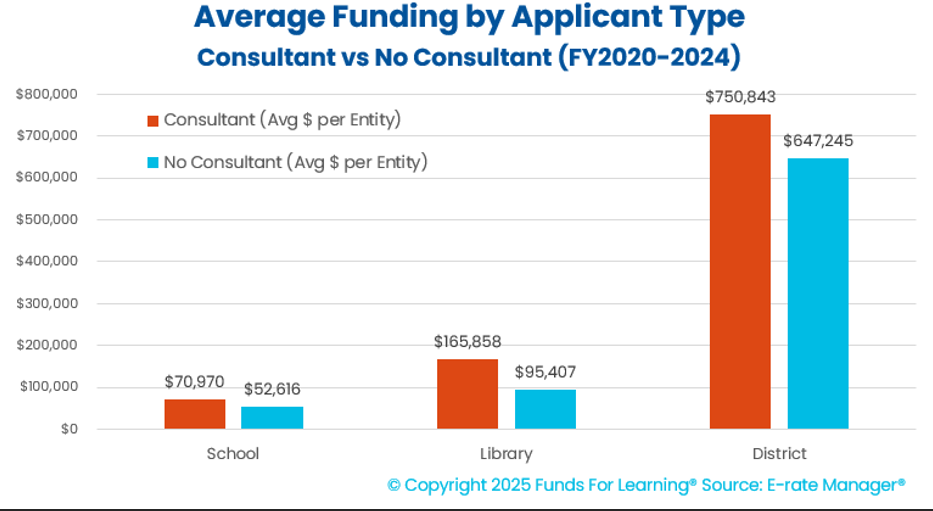Internet access is essential in education—it’s no longer a nice-to-have. The FCC’s E-rate program provides critical funding to help schools and libraries stay connected, but the application process is complex. That complexity raises a key question: Does hiring a consultant actually improve E-rate outcomes?
Key Findings
Our five-year analysis (2020–2024) covering more than 25,000 applicants shows a clear trend: consultants make a measurable difference. Here’s how:
- Individual schools see the biggest lift: Independently applying schools (not part of district filings) that use consultants enjoy a 23-point higher commitment rate—75.4% vs 52.3%.
- Libraries secure 74% more funding: Consultant-assisted libraries average $165,858 in funding, compared to $95,407 for those going it alone.
- Wi-Fi funding benefits most: For internal connections (C2), consultant-supported applicants are 5 points more likely to receive funding.
- Impact is growing: In 2024, applicants with consultants had a 6.3-point higher commitment rate than those without.
- Overall financial boost: Consultant-assisted applicants receive, on average, 22.2% more funding—$508,307 vs $415,825.

Where Consultants Deliver the Greatest Impact
Some applicant types benefit more than others:
- Individual schools: The 23-point gap underscores how difficult it can be for solo applicants to navigate E-rate successfully without professional help.
- Libraries: With smaller IT teams and less procurement experience, libraries see major gains—74% more funding—with consultant support.
Why Wi-Fi Matters (and Why It’s Harder)
Consultants don’t make as much difference for internet access (C1), but they do for internal connections (C2):
- Consultant-supported C2 applicants had a 78.1% success rate vs 73.1% without.
- This gap likely stems from the more detailed nature of internal connections.
A Growing Gap
Consultants appear to matter more as time goes on. In 2024, the advantage for consultant-assisted applicants reached 6.3 percentage points.
Size Matters, But Not How You’d Expect
Consultant use increases with applicant size:
- Only 27.5% of small entities (1–5 sites) use consultants.
- But 65.9% of large applicants (100+ sites) do.
That said, small entities gain the most from consultant support. The catch? They’re the least likely to hire one.
Recommendations
If you’re applying for E-rate, here’s what the data says:
- Individual schools: If you’re applying on your own, consultant support can double your odds of success.
- Libraries: The funding gap speaks for itself—expertise pays off.
- C2 applicants: Internal connections funding is complex. Professional guidance helps.
- Smaller applicants: You may not think you need help—but you likely stand to gain the most from it.
Conclusion
The data is clear: using a consultant improves E-rate outcomes. That’s especially true for applicants with less internal capacity, those applying for Wi-Fi funding, and schools or libraries navigating the process solo. As the E-rate landscape evolves and competition for funding increases, professional guidance isn’t just helpful—it’s becoming a strategic advantage.

